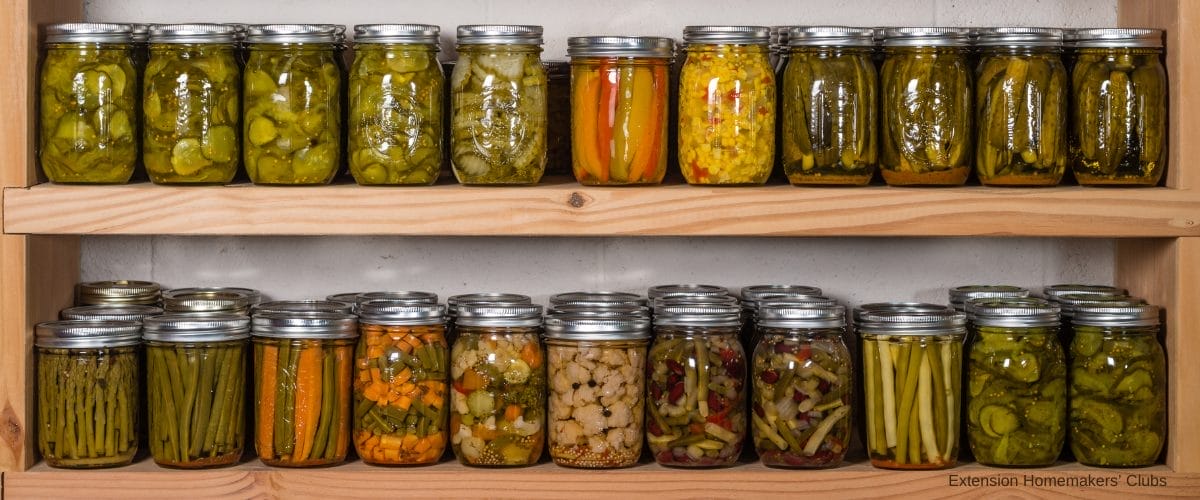

Uh oh...
It appears that you're using a severely outdated version of Safari on Windows. Many features won't work correctly, and functionality can't be guaranteed. Please try viewing this website in Edge, Mozilla, Chrome, or another modern browser. Sorry for any inconvenience this may have caused!
Read More about this safari issue.

In 1912, opportunities for women, particularly women living in rural Arkansas, were few and far between. The United States was in the midst of the Progressive Era when many people advocated for social, political and economic reforms. These included pushes for Prohibition, Women’s Suffrage, and a greater focus on social reforms and education.
Out of this movement, clubs of women and girls formed to teach women how to manage farm life and adopt new techniques. Oklahoma is credited with creating the first “farming clubs” around 1910, but Arkansas wasn’t far behind. In 1912 in Mabelvale, Arkansas, Emma Archer organized a canning club for girls and women. This was the first of what became known as home demonstration clubs.
By 1914, the federal government recognized the ability of these clubs to reach rural women and effect change. The U.S. Department of Agriculture’s Cooperative Extension Service took the initiative to formalize the clubs and hired agents to oversee enrollment and demonstrations. The clubs were originally segregated. The agents ensured the clubs focused on methods women could adopt to lessen labor, improve their homes, and encourage better living conditions for themselves, their neighbors and their communities. Arkansan Elizabeth Griffin Hill researched the Arkansas Home Demonstration Clubs extensively for her book, “A Splendid Piece of Work:1912-2012: One Hundred Years of Arkansas’s Home Demonstration and Extension Homemakers Clubs.”

Hill found that the first ten clubs were “based on their proximity to railroad lines so the agent could make it to meetings.” One of the first methods taught within the clubs was the practice of canning food. Canning food became popular beginning in 1850, and it was a task that could be accomplished at home, allowing farmers to save food over the winter and provide for their families. Agents led demonstrations on canning methods, particularly the cold pack canning method where raw fruits and vegetables were placed in jars and set in a boiling water bath or pressure canner. These techniques were essential to keep food from spoiling or becoming contaminated. Contaminated canned food could cause botulism, a lethal illness. Between 1899 and 1949, the CDC recorded 1281 cases of botulism, so this was an important and popular topic among the clubs.

Canning was only one focus for home demonstration clubs. World War I began, and soon, the U.S. was focused on increasing the food supply across Europe. Even before the U.S. entered the war, home demonstration clubs focused on efforts to save food and send it to Europe. The U.S. Food Administration was created in 1917 to spearhead this effort with slogans like “Meatless Mondays” and “Wheatless Wednesdays.” In Arkansas, members of the home demonstration clubs rose to the occasion by holding demonstrations on how to make cottage cheese, which became a common substitution for meat. In her research, Hill found detailed demonstration club notes on the number of women making cottage cheese, the pounds made, and even cottage cheese specialists hired to help with demonstrations. Members were also encouraged to grow victory gardens and, of course, can food from their gardens.

The home demonstration clubs were part of a successful effort to save food. The effort was so successful that when World War I ended, the country had a food surplus. This depressed food prices in agricultural states like Arkansas, which had increased crop production through the war years. With oversupply and falling prices, the state began to experience a depression nine years before the Great Depression began.
During this time, the clubs rightly focused on alleviating hunger. Some clubs started cooking for local schools several times a week to offer children hot meals. In her work, Griffin noted one teacher’s observations after the local club began providing meals at school. Class performance improved, but the teacher also found the children’s dispositions on the playground improved as well. The clubs ran the school cafeterias with volunteers and raised funds for school kitchens by hosting fundraising dinners. Some clubs served schoolchildren four times a week, offering at least hot soup and crackers, while larger meals included pork, potatoes and even cookies.
Home demonstration clubs also found ways to recycle clothing and use what was available to them. Flour sacks and other food items came in cotton bags, and as the economy dipped, women began to sew clothes from these bags. Feed sacks were another source material, and feed sack manufacturers took notice of the trend and started issuing feed sacks in colors and prints that could be used for dresses. The home demonstration clubs learned how to wash labels from these sacks and stitch them into fashionable clothes. The women also learned how to unstitch old clothes that needed patching and either patch the material or create a new clothing item from the old. Another popular activity in the clubs during the 1930s was making homemade cotton mattresses. These mattresses were stuffed with surplus cotton and provided families with some of their first cotton mattresses.
The 1940s brought a lot of change to home demonstration clubs and the lives of women in Arkansas. Club membership in the state hit its highest level, with 65,000 women enrolled in December of 1941. As in World War I, food was at the forefront of the war effort at home. Home demonstration clubs once again emphasized planting gardens and taught members to grow vegetables and can them. They continued their efforts to provide school children with lunches. Many women also began entering the workforce to fill roles left behind by men who had joined the army. This meant enrollment in clubs began dropping slowly but surely.
After World War II ended, many women still wanted to work. The focus for home demonstration club enrollment began to shift to younger women, many of whom were GI wives, and women who married American soldiers abroad and came to the U.S. By 1952, 28% of women in Arkansas were working outside the home, a number that would only increase while home demonstration club membership decreased.

In 1966, the home demonstration clubs officially desegregated, with the separate clubs for white and black women coming together under a new name, the Extension Homemakers Council. The clubs under this new moniker continued to serve women in the state. Today, the Extension Homemakers Council has over 3,700 members in Arkansas and over 300 clubs, which are open to anyone in the community interested in joining and learning new skills. These clubs continue to focus on informal educational opportunities under three pillars: lifelong learning, community service and leadership development. These three ideas can be traced to the original home demonstration clubs’ focus on learning, serving their communities, and creating women leaders in the process.
In a presentation about home demonstration clubs and the book “A Splendid Piece of Work,” Elizabeth Griffin Hill said, “My focus is to get the word out so our wonderful unsung heroines won’t be forgotten again.” The home demonstration clubs are part of the history of educational enrichment and social empowerment of women in Arkansas.
Visit Arkansas Extension Homemakers Council-UAEX on Facebook to learn more about the current clubs and how to join one near you.
We do the work.
You check your email.
Sign up for our weekly e-news.
Get stories sent straight to your inbox!










Like this story? Read more from Kimberly Mitchell
The American Black Walnut is a unique nut for many reasons, and Arkansas...
The Razorbacks are famous across Arkansas and beyond. Many sports fans...
Women’s volleyball has become a central sport in Arkansas, deeply...
Join the Conversation
Leave a Comment